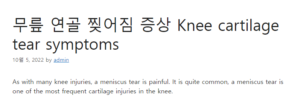As with many knee injuries, a meniscus tear is painful. It is quite common, a meniscus tear is one of the most frequent cartilage injuries in the knee.
The cartilage in the knee cushions and stabilizes the joint and protects the bone from wear and tear. In some cases, the torn pieces of cartilage loosen and become trapped in the knee joint.
Meniscus tears are common in contact sports such as soccer, as well as in non-contact sports that require jumping and amputation, such as volleyball and soccer. They can occur when you change direction suddenly while running and often coincide with other knee injuries, such as an anterior cruciate ligament injury.

The meniscus is a particular risk for older athletes because the meniscus weakens with age. More than 40% of the population over the age of 65 suffers.
Knee cartilage tear symptoms
Knee cartilage tear symptoms
Symptoms of a knee meniscus tear include:
knee pain
edema
a popping sensation during injury
Difficulty flexing and straightening the leg
Tendency of the knee to “stick” or lock 무릎 연골 찢어짐 증상
The pain may not be bad at first. You can also play through injuries. But once inflamed, your knee will be pretty sore.
To diagnose a meniscus tear, your doctor will give you a thorough examination. They’ll want to hear more about how you were injured. X-rays may be needed to rule out broken bones and other problems. A magnetic resonance imaging (MRI) scan may be needed to evaluate the knee cartilage in more detail.
Prevention of knee cartilage tear 좋은뉴스
A meniscus tear is difficult to prevent because it is usually the result of an accident. However, some precautions can lower your risk of knee injuries. You must:
Keep your thigh muscles strong with regular exercise.
Warm up with light activity before participating.
Give your body time to rest between workouts. Tired muscles can increase your risk of injury.
Make sure your shoes are well supported and fit correctly.
Increase your flexibility.
Increase the intensity of your workout slowly.
Treatment of Knee Cartilage Tears
Treatment for a meniscus tear depends on the size and location of the tear. Other factors that affect treatment include age, activity level, and related injuries. The outer part of the meniscus, often referred to as the “red area,” can heal on its own if the blood supply is good and the tear is small.
In contrast, the inner two-thirds of the meniscus, known as the “white area,” has poor blood supply. Tears in this area do not heal on their own because there are no blood vessels supplying them with healing nutrients.
Fortunately, not all meniscus ruptures require surgery. If the knee is stable and not immobilized, and the symptoms resolve, non-surgical treatment may be sufficient. To speed up recovery, you can:
Avoid using your knees as much as possible.
If your knee hurts, limit activities that include walking. Use crutches to relieve pain.
Apply ice to your knee to reduce pain and swelling.
Do this for 15-20 minutes for 2-3 days or every 3-4 hours until pain and swelling are gone.
Compress your knees.
Use an elastic bandage or neoprene sleeve on the knee to control swelling.
When sitting or lying down, place your knees under your heels with a pillow.
Take anti-inflammatory drugs.
Non-steroidal anti-inflammatory drugs (NSAIDs) such as Advil, Aleve, or Motrin can help with pain and swelling. However, these drugs may have side effects, such as bleeding and an increased risk of ulcers. It should only be used occasionally, unless your doctor specifically tells you otherwise.
Use stretching and strengthening exercises to reduce stress on your knees.
See a physical therapist for treatment if needed. Running,
Avoid shocking activities such as jumping.
These conservative treatments are not all. If the tear is large, unstable, or causes locking symptoms, surgery may be required to repair or remove the unstable edge. The process is usually very simple, and most people can go home the same day. If repairs are performed, braces may be needed later for protection.
85 to 90% of people who have surgery for a meniscus tear have good or good short-term results. However, people with large meniscus damage that cannot be repaired in the long run may be at a higher risk of developing arthritis in the knee.
Recovery period after meniscus treatment
The recovery period of the knee depends on several factors, including the extent of the meniscus tear. Full recovery from surgery can take 4 to 6 weeks, depending on the type of procedure performed and other factors. But keep in mind that people also heal at different rates. In most cases, physical therapy is used to minimize postoperative complications and speed up recovery.
If your health care provider agrees, you can start a new activity that doesn’t make your knee pain worse while you recover. For example, a runner might try to swim.
Whatever you do, do not rush. Do not immediately return to your previous level of physical activity until you have:
You can fully flex or straighten your knee without pain.
No pain in the knee when walking, jogging, sprinting or jumping.
My knee no longer swells.
An injured knee is just as strong as an uninjured knee.
If you start using your knee before it heals, you can cause additional injuries.